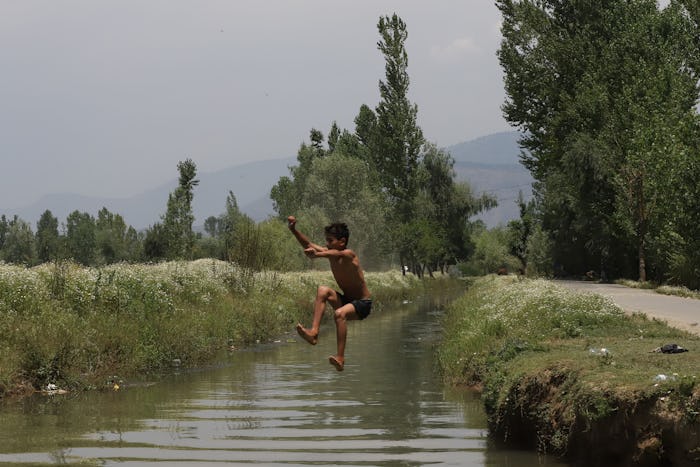Life

Are Creeks Safe For Kids To Play In This Summer? Experts Explain
Every summer, families flock to their nearest pools and ponds to hop in and cool off. Families who live near bodies of water, like rivers, streams, lakes, and springs may choose a more natural spot to splash in, but are creeks safe for kids to play in? It’s around this time each year we begin seeing headlines about flesh-eating bacteria or drowning deaths, and sadly, that’s not a coincidence.
James Waler, M.D., board-certified pediatrician at Baptist Health in Jacksonville, Florida, knows how easy it is for kids to get sick in hot bodies of water. He tells Romper in an interview that, in his experience, kids with tubes in their ears are especially prone to infection from water-borne organisms.
“When bodies of water that are not chlorinated get into an ear canal that has a tube, it may contain organisms that are certainly readily available in rivers, ponds, or lakes. It can potentially pose health problems and typically ENTs discourage kids with tubes from getting in those bodies of water," he says.
Typically, tubes in the ear allow water to flow easily in and out — Waler says that’s the way they prevent ear infections. That’s why sterile, chlorine-treated water isn’t a concern. But kids swimming in natural bodies of water, ear tubes or not, are susceptible to dangerous amoebas. The Centers for Disease Control and Prevention (CDC) note that Naegeleria fowleri, the notorious “brain-eating amoeba,” is the one to watch for.
“For kids who like to swim in small bodies of water, like ponds or small lakes that don’t have flow and get heated by daily sun, it can activate the amoeba dwelling on the bottom sediment of these ponds,” says Waler. “Kids like to jump in, and it stirs up the sediment and the amoeba. The amoeba can actually get into their nose and up into their brain, causing amoebic encephalitis. That invariably is almost 100% mortality. I try to encourage kids in southern areas to not do that in the summertime.”
Amanda Abramczyk-Thill, injury prevention specialist at Children’s Hospital Colorado, says in her interview with Romper that while those waterborne organisms are dangerous, swimming safety is important in creeks and lakes, too.
“After age 5, children are more likely to drown in natural water — ponds, lakes, rivers, streams — compared to pools,” she says. “Regarding open water, you have a current, obstructions under the water you don’t see, or debris that can come down the river. There can be unexpected drop-offs that compound the risk with that current and catch a child by surprise. If that child is with you, but they might get away from you, it’s hard to catch up to them in water that flows.”
Abramczyk-Thill says that for children to safely swim in open water, they should be able to:
- Step into water above their heads and return to the surface
- Tread water for one minute
- Float
- Turn in a full circle to find a way out of the water
- Swim about 25 yards in water to demonstrate the strength/endurance needed to get to safety
She explains that in Colorado, about half the drownings in children occur in open water. “There’s no specific information available about why, but with any open water you have to consider depth,” Abramczyk-Thill says. “If anyone is diving in, they can hit their head in the water, get caught under things if they’re going downstream like a rock, tree, tree branches, a canoe, or another recreational device.”
Waler and Abramczyk-Thill agree the best thing parents can do while swimming in a natural body of water is to assign a water watcher, as recommended by Safe Kids Worldwide. “If you have children playing in moving water, you want to make sure you have at least one adult supervising the children and it’s an appropriate number of children. And you want to make sure those shifts stay about 15 minutes in length and that all adults agree on what that job entails,” says Abramczyk-Thill. “Adults should really learn CPR; CPR classes can be found for anyone in any area at redcross.org.”
You can also use coast-guard approved lifejackets when in natural bodies of water, and Waler encourages parents to be aware of your family’s surroundings in the environment. Bypassing the pool for a river, lake, or spring means there could be other species of families sharing the water with you.
“These freshwater bodies are going to have reptiles, and that can include water moccasins and potentially alligators, and they’re very active when the water temperature is as high as it is,” he says.
Experts:
James Waler, M.D., board-certified pediatrician at Baptist Health in Jacksonville, Florida
Amanda Abramczyk-Thill, injury prevention specialist at Children’s Hospital Colorado
This article was originally published on